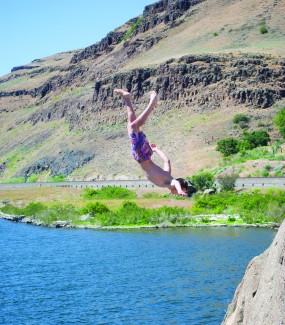Cliff diving has been a popular activity among adrenaline seekers for years, but more recently it’s becoming popular among 20-somethings just looking for something fun to do in the summer sun.
A popular cliff diving spot for University of Idaho and Washington State University students is Granite Point, also known as “The Cliffs.” Granite Point is located 40 minutes Southwest of Pullman on the Snake River. The giant boulder is a popular place for climbers, sunbathers and thrill seekers. The land, however, is owned and maintained by the U.S. Army Corp of Engineers.
Although it may be thrilling, the cliff diving experience is also risky. Cliff diving is considered a dangerous extreme sport because of the amount of stress caused to the body.

Anna Lau | Summer Arg
Luke Shaw does a backflip off of the tallest cliff at Granite Point, a popular cliff diving and rock climbing destination on the Snake River 40 minutes Southwest of Pullman. The land is owned and maintained by the U.S. Army Corp of Engineers.
The Glen Canyon Natural History Association said that if you jump from 20 feet you’ll be traveling down at a speed of about 25 mph. The impact on the water at that speed is enough to cause spinal compression, bone fractures, or concussions if you land even slightly off center.
“We have a district policy that prohibits jumping off of cliffs,” said Joe Maxwell, the Natural Resource Manager for the Corp of Engineers. “So it is something we do not encourage.”
Maxwell said they own 100 miles of river and, due to limited staff, cannot patrol and keep watch over all the sights.
“However, safety is a big concern for the Corp of Engineers,” Maxwell said.
The biggest concern about diving is the fact that the depth of the water can be drastically different in different parts of the river.
“The depth can go from several inches to 20 or 30 feet in just the matter of a few yards,” said Mike Beiser, University of Idaho outdoor programs coordinator.
Through the outdoor program, Beiser takes UI students on many water-related trips, but he said cliff jumping of any sort is off limits to everybody under the university’s code of conduct.
“A few years ago somebody jumped off a navigation tower into the river and then never surfaced,” said Paul Reavis, Whitman County sheriff’s office deputy. “We recovered the body a couple days later.”
Although there are many examples of the dangers of cliff diving, Maxwell said enforcing a no-cliff diving policy is near impossible.
“We don’t have the mere power to enforce the no-cliff diving policy,” Maxwell said. “So we instead try to educate the public on the dangers of it and hope that they’ll use some judgment before participating in high-risk behavior.”
Aaron Bharucha can be reached at [email protected]
